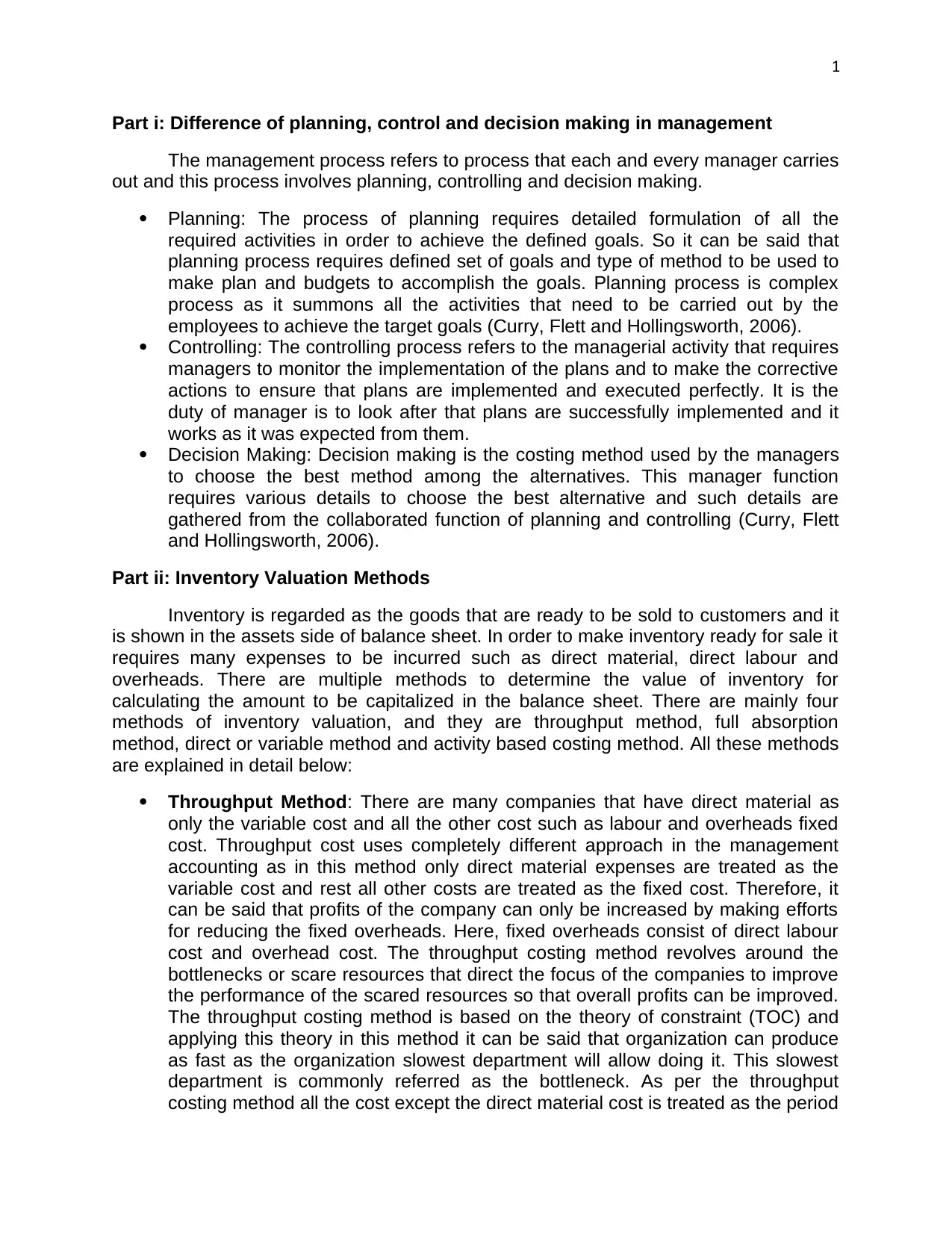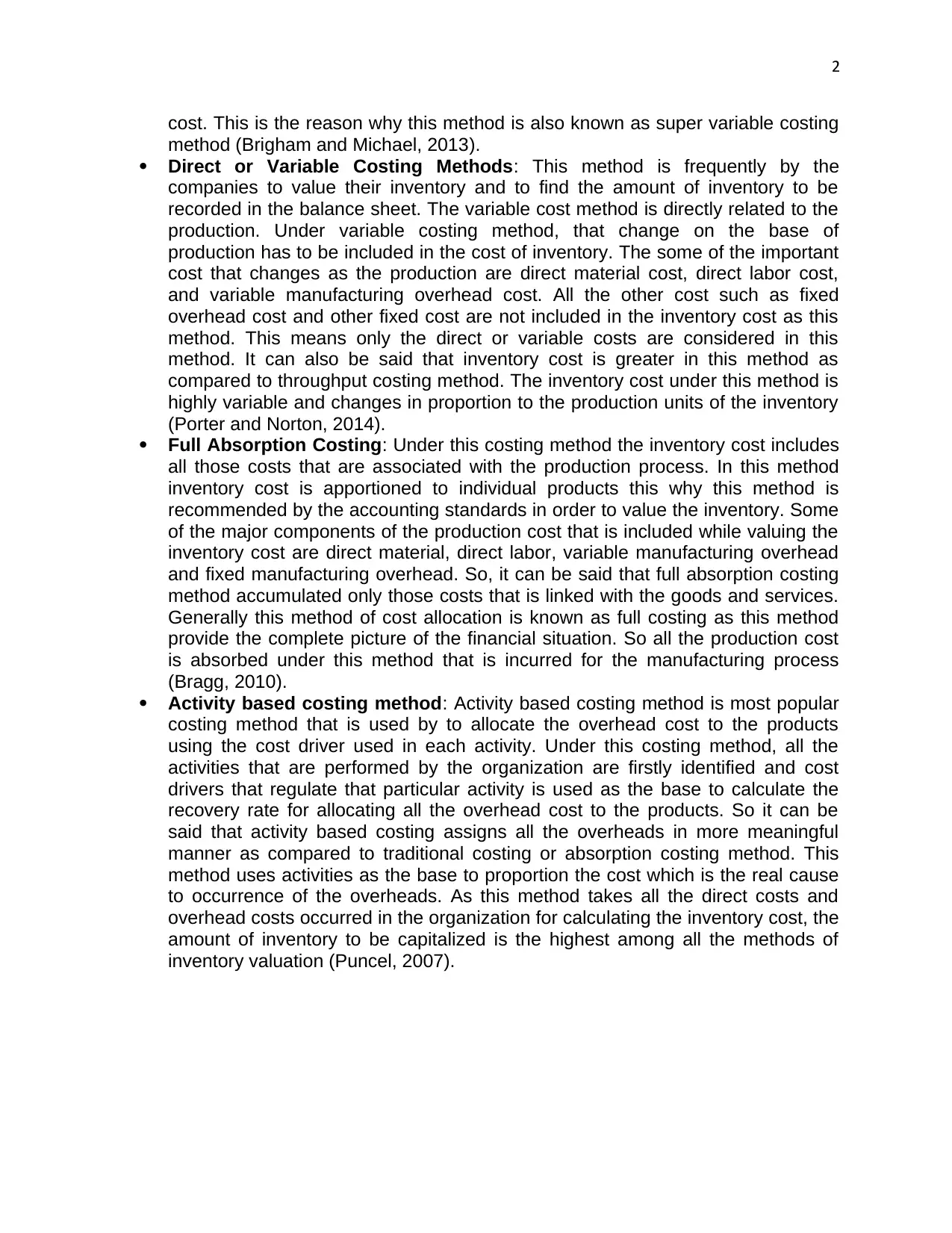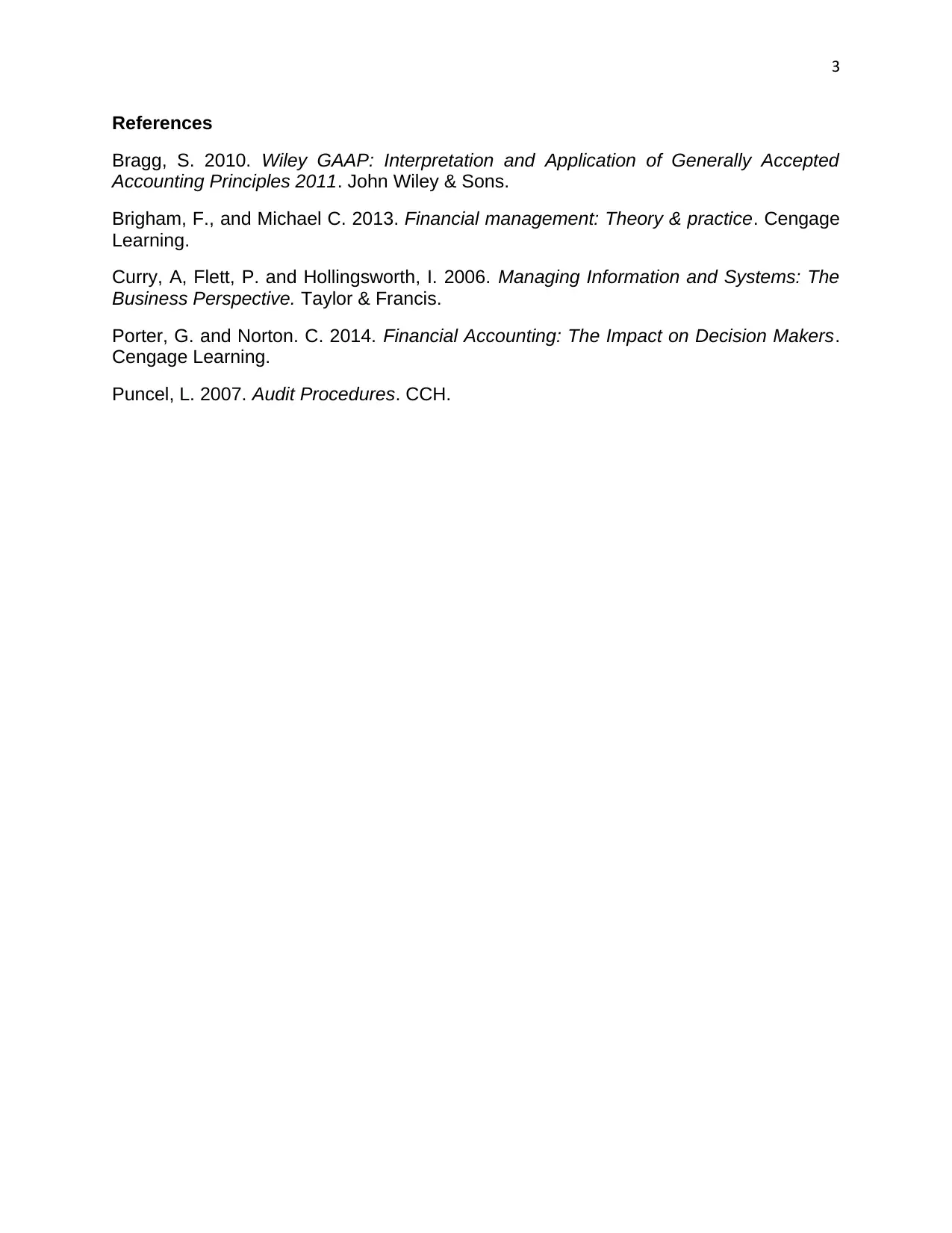Analysis of Management Processes and Inventory Valuation Methods
VerifiedAdded on 2021/04/17
|3
|1193
|33
Report
AI Summary
This report analyzes key management processes, including planning, controlling, and decision-making, highlighting their interdependencies. It then delves into various inventory valuation methods, such as throughput, full absorption, direct or variable costing, and activity-based costing. The report provides detailed explanations of each method, discussing their applications and implications for financial reporting. It emphasizes the importance of understanding these methods for accurate inventory valuation and effective financial management. The discussion includes the strengths and weaknesses of each method, helping to provide a comprehensive overview of inventory valuation techniques used in accounting and financial analysis. Furthermore, the report uses references to support the claims made.

1
Part i: Difference of planning, control and decision making in management
The management process refers to process that each and every manager carries
out and this process involves planning, controlling and decision making.
Planning: The process of planning requires detailed formulation of all the
required activities in order to achieve the defined goals. So it can be said that
planning process requires defined set of goals and type of method to be used to
make plan and budgets to accomplish the goals. Planning process is complex
process as it summons all the activities that need to be carried out by the
employees to achieve the target goals (Curry, Flett and Hollingsworth, 2006).
Controlling: The controlling process refers to the managerial activity that requires
managers to monitor the implementation of the plans and to make the corrective
actions to ensure that plans are implemented and executed perfectly. It is the
duty of manager is to look after that plans are successfully implemented and it
works as it was expected from them.
Decision Making: Decision making is the costing method used by the managers
to choose the best method among the alternatives. This manager function
requires various details to choose the best alternative and such details are
gathered from the collaborated function of planning and controlling (Curry, Flett
and Hollingsworth, 2006).
Part ii: Inventory Valuation Methods
Inventory is regarded as the goods that are ready to be sold to customers and it
is shown in the assets side of balance sheet. In order to make inventory ready for sale it
requires many expenses to be incurred such as direct material, direct labour and
overheads. There are multiple methods to determine the value of inventory for
calculating the amount to be capitalized in the balance sheet. There are mainly four
methods of inventory valuation, and they are throughput method, full absorption
method, direct or variable method and activity based costing method. All these methods
are explained in detail below:
Throughput Method: There are many companies that have direct material as
only the variable cost and all the other cost such as labour and overheads fixed
cost. Throughput cost uses completely different approach in the management
accounting as in this method only direct material expenses are treated as the
variable cost and rest all other costs are treated as the fixed cost. Therefore, it
can be said that profits of the company can only be increased by making efforts
for reducing the fixed overheads. Here, fixed overheads consist of direct labour
cost and overhead cost. The throughput costing method revolves around the
bottlenecks or scare resources that direct the focus of the companies to improve
the performance of the scared resources so that overall profits can be improved.
The throughput costing method is based on the theory of constraint (TOC) and
applying this theory in this method it can be said that organization can produce
as fast as the organization slowest department will allow doing it. This slowest
department is commonly referred as the bottleneck. As per the throughput
costing method all the cost except the direct material cost is treated as the period
Part i: Difference of planning, control and decision making in management
The management process refers to process that each and every manager carries
out and this process involves planning, controlling and decision making.
Planning: The process of planning requires detailed formulation of all the
required activities in order to achieve the defined goals. So it can be said that
planning process requires defined set of goals and type of method to be used to
make plan and budgets to accomplish the goals. Planning process is complex
process as it summons all the activities that need to be carried out by the
employees to achieve the target goals (Curry, Flett and Hollingsworth, 2006).
Controlling: The controlling process refers to the managerial activity that requires
managers to monitor the implementation of the plans and to make the corrective
actions to ensure that plans are implemented and executed perfectly. It is the
duty of manager is to look after that plans are successfully implemented and it
works as it was expected from them.
Decision Making: Decision making is the costing method used by the managers
to choose the best method among the alternatives. This manager function
requires various details to choose the best alternative and such details are
gathered from the collaborated function of planning and controlling (Curry, Flett
and Hollingsworth, 2006).
Part ii: Inventory Valuation Methods
Inventory is regarded as the goods that are ready to be sold to customers and it
is shown in the assets side of balance sheet. In order to make inventory ready for sale it
requires many expenses to be incurred such as direct material, direct labour and
overheads. There are multiple methods to determine the value of inventory for
calculating the amount to be capitalized in the balance sheet. There are mainly four
methods of inventory valuation, and they are throughput method, full absorption
method, direct or variable method and activity based costing method. All these methods
are explained in detail below:
Throughput Method: There are many companies that have direct material as
only the variable cost and all the other cost such as labour and overheads fixed
cost. Throughput cost uses completely different approach in the management
accounting as in this method only direct material expenses are treated as the
variable cost and rest all other costs are treated as the fixed cost. Therefore, it
can be said that profits of the company can only be increased by making efforts
for reducing the fixed overheads. Here, fixed overheads consist of direct labour
cost and overhead cost. The throughput costing method revolves around the
bottlenecks or scare resources that direct the focus of the companies to improve
the performance of the scared resources so that overall profits can be improved.
The throughput costing method is based on the theory of constraint (TOC) and
applying this theory in this method it can be said that organization can produce
as fast as the organization slowest department will allow doing it. This slowest
department is commonly referred as the bottleneck. As per the throughput
costing method all the cost except the direct material cost is treated as the period
Paraphrase This Document
Need a fresh take? Get an instant paraphrase of this document with our AI Paraphraser

2
cost. This is the reason why this method is also known as super variable costing
method (Brigham and Michael, 2013).
Direct or Variable Costing Methods: This method is frequently by the
companies to value their inventory and to find the amount of inventory to be
recorded in the balance sheet. The variable cost method is directly related to the
production. Under variable costing method, that change on the base of
production has to be included in the cost of inventory. The some of the important
cost that changes as the production are direct material cost, direct labor cost,
and variable manufacturing overhead cost. All the other cost such as fixed
overhead cost and other fixed cost are not included in the inventory cost as this
method. This means only the direct or variable costs are considered in this
method. It can also be said that inventory cost is greater in this method as
compared to throughput costing method. The inventory cost under this method is
highly variable and changes in proportion to the production units of the inventory
(Porter and Norton, 2014).
Full Absorption Costing: Under this costing method the inventory cost includes
all those costs that are associated with the production process. In this method
inventory cost is apportioned to individual products this why this method is
recommended by the accounting standards in order to value the inventory. Some
of the major components of the production cost that is included while valuing the
inventory cost are direct material, direct labor, variable manufacturing overhead
and fixed manufacturing overhead. So, it can be said that full absorption costing
method accumulated only those costs that is linked with the goods and services.
Generally this method of cost allocation is known as full costing as this method
provide the complete picture of the financial situation. So all the production cost
is absorbed under this method that is incurred for the manufacturing process
(Bragg, 2010).
Activity based costing method: Activity based costing method is most popular
costing method that is used by to allocate the overhead cost to the products
using the cost driver used in each activity. Under this costing method, all the
activities that are performed by the organization are firstly identified and cost
drivers that regulate that particular activity is used as the base to calculate the
recovery rate for allocating all the overhead cost to the products. So it can be
said that activity based costing assigns all the overheads in more meaningful
manner as compared to traditional costing or absorption costing method. This
method uses activities as the base to proportion the cost which is the real cause
to occurrence of the overheads. As this method takes all the direct costs and
overhead costs occurred in the organization for calculating the inventory cost, the
amount of inventory to be capitalized is the highest among all the methods of
inventory valuation (Puncel, 2007).
cost. This is the reason why this method is also known as super variable costing
method (Brigham and Michael, 2013).
Direct or Variable Costing Methods: This method is frequently by the
companies to value their inventory and to find the amount of inventory to be
recorded in the balance sheet. The variable cost method is directly related to the
production. Under variable costing method, that change on the base of
production has to be included in the cost of inventory. The some of the important
cost that changes as the production are direct material cost, direct labor cost,
and variable manufacturing overhead cost. All the other cost such as fixed
overhead cost and other fixed cost are not included in the inventory cost as this
method. This means only the direct or variable costs are considered in this
method. It can also be said that inventory cost is greater in this method as
compared to throughput costing method. The inventory cost under this method is
highly variable and changes in proportion to the production units of the inventory
(Porter and Norton, 2014).
Full Absorption Costing: Under this costing method the inventory cost includes
all those costs that are associated with the production process. In this method
inventory cost is apportioned to individual products this why this method is
recommended by the accounting standards in order to value the inventory. Some
of the major components of the production cost that is included while valuing the
inventory cost are direct material, direct labor, variable manufacturing overhead
and fixed manufacturing overhead. So, it can be said that full absorption costing
method accumulated only those costs that is linked with the goods and services.
Generally this method of cost allocation is known as full costing as this method
provide the complete picture of the financial situation. So all the production cost
is absorbed under this method that is incurred for the manufacturing process
(Bragg, 2010).
Activity based costing method: Activity based costing method is most popular
costing method that is used by to allocate the overhead cost to the products
using the cost driver used in each activity. Under this costing method, all the
activities that are performed by the organization are firstly identified and cost
drivers that regulate that particular activity is used as the base to calculate the
recovery rate for allocating all the overhead cost to the products. So it can be
said that activity based costing assigns all the overheads in more meaningful
manner as compared to traditional costing or absorption costing method. This
method uses activities as the base to proportion the cost which is the real cause
to occurrence of the overheads. As this method takes all the direct costs and
overhead costs occurred in the organization for calculating the inventory cost, the
amount of inventory to be capitalized is the highest among all the methods of
inventory valuation (Puncel, 2007).

3
References
Bragg, S. 2010. Wiley GAAP: Interpretation and Application of Generally Accepted
Accounting Principles 2011. John Wiley & Sons.
Brigham, F., and Michael C. 2013. Financial management: Theory & practice. Cengage
Learning.
Curry, A, Flett, P. and Hollingsworth, I. 2006. Managing Information and Systems: The
Business Perspective. Taylor & Francis.
Porter, G. and Norton. C. 2014. Financial Accounting: The Impact on Decision Makers.
Cengage Learning.
Puncel, L. 2007. Audit Procedures. CCH.
References
Bragg, S. 2010. Wiley GAAP: Interpretation and Application of Generally Accepted
Accounting Principles 2011. John Wiley & Sons.
Brigham, F., and Michael C. 2013. Financial management: Theory & practice. Cengage
Learning.
Curry, A, Flett, P. and Hollingsworth, I. 2006. Managing Information and Systems: The
Business Perspective. Taylor & Francis.
Porter, G. and Norton. C. 2014. Financial Accounting: The Impact on Decision Makers.
Cengage Learning.
Puncel, L. 2007. Audit Procedures. CCH.
⊘ This is a preview!⊘
Do you want full access?
Subscribe today to unlock all pages.

Trusted by 1+ million students worldwide
1 out of 3
Related Documents
Your All-in-One AI-Powered Toolkit for Academic Success.
+13062052269
info@desklib.com
Available 24*7 on WhatsApp / Email
![[object Object]](/_next/static/media/star-bottom.7253800d.svg)
Unlock your academic potential
Copyright © 2020–2025 A2Z Services. All Rights Reserved. Developed and managed by ZUCOL.




